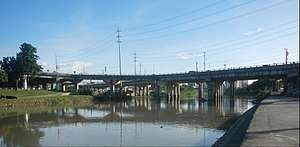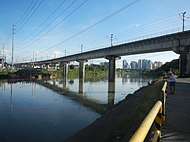Transportation in Metro Manila
The transportation system in Metro Manila is currently inadequate to accommodate the mobility and other basic needs of an densely populated metropolis, the result of many factors and problems that the government has failed to provide or address. Metro Manila exists in a state of near-permanent gridlock, with people and goods trapped by the very transportation system that is supposed to move them quickly and efficiently.[1]
_(14765708731).jpg)
Because of the insufficient public transportation network, car ownership has risen dramatically, contributing further to the congestion that occurs at all times of day on the road.[2] In recent years, however, the Philippine government has been pushing to improve the system through various infrastructure projects,[3] hoping to solve the interlinked problems of transportation, land use and environment.[4]
Since the government shifted the infrastructure needs of Metro Manila into sharper focus with the "Build Build Build" program of the Duterte administration, traffic relief will gradually become a reality. The program aims to usher in "a golden age of infrastructure" in the country, with most of the 75 projects lined up and in various stages of completion directly impacting the Greater Capital Region, composed of Metro Manila, Region 3 (Central Luzon) and Region 4A (Calabarzon).[5]
Infrastructure
Roads
The existing main roads of Metro Manila are organized around a set of Radial and Circumferential roads established during the American period in the country's history. All R roads originate from various points in the city of Manila and radiate south, east or north to the other cities in Metro Manila and end farther out into the Greater Capital Region and beyond. In a similar way, all C roads run in a half circle that begins and ends at Manila Bay, with Manila at the innermost circle.
The only major thoroughfare in Metro Manila not included in the arterial road system is Dr. Arcadio Santos Avenue (formerly Sucat Road) in Paranaque, designated as Highway N63.
Radial roads
- Radial Road 1 - Anchored on Roxas Blvd, from Bonifacio Drive up to and including Cavitex in Kawit, Cavite. A portion of Roxas Blvd is designated as Highway N61.
- Radial Road 2 - Anchored on Taft Avenue, from the Lagusnilad Underpass in front of Manila City Hall up to and including Aguinaldo Highway in Cavite. Part of the road is designated Highway N62.
- Radial Road 3 - Anchored on Osmena Highway/SLEX, from Quirino Avenue through to the Santo Tomas exit in Batangas.
- Radial Road 4 - An incomplete road, it starts from Pedro Gil Street through Makati where the main part of the road is J.P.Rizal Avenue. From there, the road is undefined until it reaches Pateros and Taytay before ending at the Manggahan Floodway.
- Radial Road 5 - Anchored on Shaw Boulevard and Ortigas Avenue, from V. Mapa Street up to and including the Manila East Road. Part of the road is designated as Highway N60.
- Radial Road 6 - Anchored on Magsaysay Boulevard and Aurora Boulevard, from Legarda Street up to and including the Marikina-Infanta Highway. The road is designated as either Highway N59 or N180 .
- Radial Road 7 - Anchored on Espana Boulevard, Quezon Avenue and Commonwealth Avenue, from Lerma up to and including Quirino Highway to Bulacan.
- Radial Road 8 - Anchored on Dimasalang Street and NLEX, from Quiapo to Clark in Pampanga.
- Radial Road 9 - Anchored on Rizal Avenue, from Carriedo to MacArthur Highway in Rosario, Pangasinan.
- Radial Road 10 - Anchored on Marcos Road in Tondo, from the Del Pan Bridge up to the intersection with C-4.
Circumferential roads
- Circumferential Road 1 - Anchored on Recto Avenue and Ayala Avenue, from Tondo to the Luneta Park.
- Circumferential Road 2 - Anchored on Lacson and Quirino avenues, from Tondo to Roxas Boulevard.
- Circumferential Road 3 - An incomplete road, anchored on Araneta Avenue, from R-10 in Navotas to Buendia Avenue in Pasay, with the broken segment in Makati.
- Circumferential Road 4 - Dominated by the whole length of EDSA, from the R-10 intersection to the Mall of Asia in Pasay.
- Circumferential Road 5 - Segments are incomplete but under construction (as of Feb. 2019), from NLEX Karuhatan segment to the FTI area in Taguig, and ultimately to the Coastal Road (Cavitex) in Las Pinas.
- Circumferential Road 6 - The beltway of Metro Manila, it will be anchored by the Southeast Metro Manila Expressway (also known as Skyway Stage 4[6]) currently under construction, from MacArthur Highway in Marilao, Bulacan to Kawit, Cavite.
Expressways
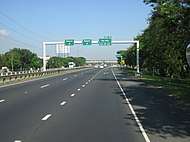
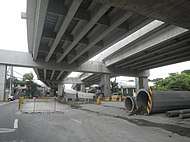
Expressways are controlled-access highways, with crossing traffic limited to overpasses, underpasses, and interchanges. Metro Manila is served by the following expressways:
There are expressways under construction or proposed. These include:
- Skyway Stage 3[7]
- Southeast Metro Manila Expressway[8]
- C-5 South Link Expressway
- C-5 Expressway
- Pasig River Expressway
- Metro Manila Skybridge[9]
- Manila–Quezon Expressway
- R-7 Expressway
Bridges
There are a total of 32 bridge spans in Metro Manila that cross the Pasig and Marikina rivers, including four rail-only bridges, the Line 1, Line 2, Line 3 and the PNR tracks.
Pasig River Bridges
The bridges are listed below in west to east order, with the first bridge nearest to the mouth of the Pasig River into Manila Bay.
- Roxas Bridge - formerly called Del Pan Bridge (San Nicolas to Port Area)
- Jones Bridge - formerly called Puente de España (Binondo to Ermita)
- MacArthur Bridge (Sta. Cruz to Ermita)
- Line 1 (Carriedo Station to Central Station)
- Quezon Bridge (Quiapo to Ermita)
- Ayala Bridge (San Miguel to Ermita)
- Mabini Bridge - formerly called Nagtahan Bridge (Sta. Mesa to Pandacan)
- Philippine National Railways (Santa Mesa Station to Pandacan Station)
- Padre Zamora Bridge formerly called Pandacan Bridge (Sta.Mesa to Pandacan)
- Lambingan Bridge (Sta. Ana)
- Makati-Mandaluyong Bridge
- Line 3 (Boni station to Guadalupe Station)
- Guadalupe Bridge (Makati to Mandaluyong)
- C.P. Garcia Bridge (Makati to Pasig)
- Kaunlaran Bridge (Pasig)
- Bambang Bridge (Pasig)
- Kalawaan Bridge (Pasig)
- Napindan Bridge (Pasig to Taguig)
Two new bridges are under construction:
- Binondo–Intramuros Bridge[10]
- BGC-Ortigas Link Bridge
- Estrella–Pantaleon Bridge[10] (reconstruction)
Marikina River Bridges
The bridges listed below are those located in Metro Manila crossing the Marikina River (listed towards the confluence with the Pasig River in a north to south order):
- Batasan-San Mateo Bridge (Quezon City to San Mateo, Rizal)
- Gil Fernando Bridge (Marikina)
- A. Bonifacio Bridge (Marikina)
- Marcos Bridge (Marikina)
- Line 2 (Santolan Station to Katipunan Station)
- Diosdado Macapagal Bridge (Quezon City to Marikina)
- Caruncho Bridge (Quezon City to Pasig)
- Rosario Bridge (Pasig)
- Sandoval Bridge (Pasig)
- Kaginhawaan Bridge (Pasig)
- Vargas Bridge (Pasig)
- Sta. Rosa de Lima Bridge (Pasig)
Public transport
Manila, being a major city, offers various transportation options. The most famous of these modes is the public jeepney, which has been in use since the years immediately after World War II. Buses, air-conditioned metered taxi, and Tamaraw FX mini-vans are also popular forms of transportation. Auto rickshaws (referred to as "tricycles" in the Philippines) and pedicabs are used for short distances. In some areas, especially in Divisoria and large public markets, two-stroke motors are fitted in the pedicabs and are used for goods transport. Regardless of modernity, horse-drawn calesas are still used in the streets of Binondo and Intramuros. Buses, taxis and trains are also other important means of public transportation in the metropolis. The metropolis is served by the Manila Light Rail Transit System (Line 1 and Line 2), the Manila Metro Rail Transit System (Line 3) and the Philippine National Railways (PNR). More train lines are planned or under construction.
Jeepneys
Jeepneys are the most popular mode of public transportation in the Philippines, they have also become a ubiquitous symbol of the Philippine culture.[11] According to the Metro Manila Dream Plan report by the Japan International Cooperation Agency (JICA), a survey made in 2007 came out with 48,366 public utility jeepneys plying some 600 routes nationwide, with 61% serving the Greater Capital Region, which includes Metro Manila. In 2000, jeepneys and tricycles topped all modes of travel in Metro Manila at 46%, before light rail became popular, followed by buses at 24% and private vehicles at 21%.[12]
In 2016, the Department of Transportation and Communications imposed an age limit on jeepneys of 15 years, with older jeepneys starting to be phased out.[13] Many jeepney operators oppose the phase-out,[14] and politicians urged the government to drop the jeepney modernization program.[15] As part of the PUV modernization program all new and existing vehicles must be fitted with a tap card system which allows commuters to pay for their trip.[16] The system would enable journey details to be recorded and the appropriate fare deducted from the stored value on the card.[17]
Buses
Aside from dilapidated jeepneys, public utility buses (PUBs) are the bane of Metro Manila's congested roads, due to their numbers, their sheer physical size, and the methods of bus drivers and conductors of loading and unloading passengers. On any given day, some 3 million vehicles pass Metro Manila's main circumferential artery, EDSA or C-4. Of the total, about 140,000 are buses, according to an article by the Philippine Center for Investigative Journalism (PCIJ).[18] "The boorish behavior of many public buses -- as well as the fact that far too many of them are on the road -- has gotten worse through the years." Figures from the LTFRB indicate that there are about 13,000 buses operating in Metro Manila run by 1,200 operators, about half of them using EDSA. In response to this, the Metropolitan Manila Development Authority (MMDA) hopes to totally remove all provincial bus terminals along EDSA by 2019.[19]
Metro Manila's bus routes are not numbered. They are mainly divided between inner and outer Metro Manila by the two busiest corridors, (C4) EDSA and C5. From the northern cities and provinces, buses use four main arteries: McArthur Highway, NLEX, Quirino Highway, and Commonwealth Avenue. From the south, city buses start from two major terminals, PITX and Alabang, which will soon see services transferred to the under construction Taguig Integrated Terminal Exchange. Going east, routes start from either Cubao through the Marilaque Highway (R6), or Ortigas Avenue (R5) to reach Antipolo, Taytay and the rest of Rizal province.
Being the trunkline road, EDSA is used by more than 30 bus routes. In comparison, other arterial roads are serviced by one bus route or none at all (being serviced by jeepneys). There is one bus on Espana and Quezon Avenue (R7) from Fairview to Baclaran, while the university district in Sampaloc has two buses going east, using the same roads, Aurora Ave and Ortigas Ave, up to either Cainta or Taytay. There are no buses on Rizal Avenue (R9) in Manila as it is served by Line 1 to Monumento.
Intermodal terminals
| Name | City | Rail line | Modes | Notes |
|---|---|---|---|---|
| Parañaque Integrated Terminal Exchange (PITX) | Parañaque | LRT Line 1 | Bus, jeepney, taxi and UV Express | Opened on November 5, 2018. Connection to LRT-1 under construction. |
| Taguig Integrated Terminal Exchange (Southern Integrated Transport Exchange, Southern ITX) | Taguig | Metro Manila Subway |
Bus, jeepney, taxi, and UV Express |
Under construction |
| Valenzuela Gateway Complex (VGC) | Valenzuela | N/A | Tricycles, buses, jeepneys and UV Express | |
| North Avenue Grand Central Station (Unified Grand Central Station) | Quezon City | LRT Line 1
Metro Manila Subway Line 9 |
To be announced | Area A under construction, Areas B and C approved |
Mass transit
Rail transport

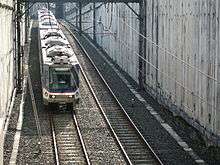
The development of mass transit had its inception in the 1970 when the Philippine National Railways offered among its services the first Metro Commuter line. Line 1, which is the first rail line operated by the Light Rail Transit Authority, a government corporation, opened in 1984, making it the first rapid rail transport in Southeast Asia. It was followed in 1999 by Line 3 along EDSA operated by the private company, Metro Rail Transit Corporation, before Line 2 was completed in 2003. Together, these four lines run by three different entities bear the brunt of providing the metropolis with rail as a faster alternative mode of transport other than buses and jeepneys. More rapid transit rail lines are in the planning stages or under construction as of 2019.
Manila Light Rail Transit System
The Manila Light Rail Transit system, run by the LRTA, is one of the main railway networks of Metro Manila.[20] It has a total of 31 stations (20 in Line 1 and 11 for Line 2), over a total of 31 kilometers of grade separated track. Line 1 runs along parts of Taft Avenue, Rizal Avenue, and Epifanio de los Santos Avenue (EDSA), traveling a north–south route through the cities of Quezon City, Caloocan, Manila, Pasay and Paranaque. On the other hand, Line 2 covers parts of Recto Avenue, Legarda Street, Magsaysay Boulevard, Aurora Boulevard, and Marikina-Infanta Highway (Marcos Highway), in an east–west route which passes through the cities of Manila, Marikina, San Juan, Quezon City, and Antipolo in Rizal. Although Line 2 has been part of the system, it is actually a heavy rail full-metro rapid transit line. Combined, the two lines have a daily ridership of 750,000.
Manila Metro Rail Transit System
The Manila Metro Rail Transit system is another railway network in Metro Manila, composed of independent railway lines not under the control or supervision of the LRTA or PNR. Currently it is only composed of one line, Line 3, which was completed in 2000.[21] This single line runs solely along Epifanio de los Santos Avenue (EDSA), one of Metro Manila's main thoroughfares. Line 3 has 13 stations along its 16.95 kilometers of grade separated track, on a north–south route which passes through the cities of Quezon City, Mandaluyong, Makati and Pasay. The busiest among the rail lines, it has a daily ridership of almost 600,000. The system is set to gain a new line in 2021 with the opening of Line 7,[22] currently under construction, which will run from the North EDSA common station through Commonwealth Avenue to San Jose del Monte, Bulacan.
PNR Metro Commuter Line
In addition to the Metro Commuter, the city is the hub of PNR's railway system on Luzon.[23] The main terminal of the Philippine National Railways is at Tutuban in the Tondo district. The North and South Commuters combined, when fully rehabilitated, will have a length of 122 kilometers from Clark in Pampanga in the north to Calamba, Laguna in the south, and stop at all 48 train stations in between. The Metro Commuter has a present ridership of 100,000 daily.
Future rail projects
The projected 2024 railway Map of Metro Manila, excluding the Makati Subway[24]
Future commuter rail and rapid transit systems are being planned and constructed in Metro Manila. Projects include:
- Rehabilitation of the current PNR Metro Commuter service to Valenzuela
- North–South Commuter Railway
- Line 1 Southern Extension Project
- Line 4
- Line 5 (Makati Subway)
- Line 6[25]
- Line 7
- Line 8, also known as the PNR East-West Railway.[26]
- Line 9 (Metro Manila Subway)
- Makati-BGC Skytrain[27]
- Line 10[28]
Bus rapid transit (BRT)
A planned introduction to the metropolis is the rapid bus transit (BRT), a system that makes use of a dedicated lane, buses with large traffic volume, suitable stations and employs intelligent transportation system. Several BRT lines have been discussed and proposed, all are pending approval.
- Bonifacio Global City Bus[29]
- EDSA
- C-5
- Quezon Avenue to Manila City Hall
Air transportation
Airports
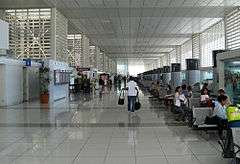
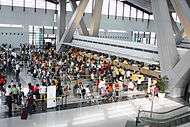
The Ninoy Aquino International Airport (IATA airport code MNL) is the main international gateway to the Philippines, located between Pasay and Parañaque, about seven kilometers south of Manila city proper and southwest of Makati. Terminal 1 only serves international flights. All foreign carriers operating in Manila use Terminal 1 except for All Nippon Airways, Cathay Pacific, Delta Air Lines, Emirates, KLM, Qantas, Qatar Airways, Singapore Airlines and United Airlines. Terminal 2 (or the Centennial Terminal), opened in October 1999, is used exclusively by Philippine Airlines for both its domestic and international service. Terminal 3, opened in August 2008, is the home terminal of Cebu Pacific, the country's second largest airline. Its international wing houses the 9 foreign carriers not using Terminal 1. It also houses some domestic flights of PAL through its subsidiary Air Philippines. Terminal 4 is used by smaller aircraft of all domestic carriers, and by Air Asia as well.
With a record-breaking 42-million people using the airport in 2017, NAIA has long breached the 30-million combined passenger capacity of its four terminals.[31] A proposal to expand NAIA, submitted by a consortium of the country's largest conglomerates, involves the expansion of the current terminals and the construction of an integrated hub as well as a second parallel runway.[31] There are also exploratory talks to transfer terminal assignments among airlines.[32]
Both NAIA and Clark International Airport, located in the Clark Freeport Zone in Angeles, Pampanga serve the Manila area, with CIA catering mostly to low-cost carriers that avail themselves of the lower landing fees than those charged at NAIA. In 2018, Clark handled 2.6 million passengers, all the while undergoing expansion to bring capacity to 12 million with the addition of a second terminal to be finished by 2020.
Proposed airports
In June 2014, JICA formally recommended the construction of a new airport in the vicinity of Sangley Point, Cavite City to replace the space-constricted NAIA. The recommendation involved the reclamation of Manila Bay to locate the new airport. This is contained in JICA's Metro Manila Dream Plan roadmap. Also, an unsolicited proposal by San Miguel Corporation, builders and concessionaires of the Manila Skyway and other infrastructure projects, has been considered by the national government. As of 2/2019, it has been approved by the NEDA pending a Swiss Challenge from other interested parties, as well as further environmental impact studies. The proposed aerotropolis will also be located at a reclaimed area of Manila Bay in Bulacan, Bulacan. (This is a current event; developments are happening fast along this issue.)
Water transportation
Seaports and piers
The Port of Manila, located in the vicinity of Manila Bay, is the chief seaport of the Philippines. It primarily serves the city's commercial needs. North Harbor and South Harbor experience busy periods during long holidays such as Holy Week, All Saints Day and the Christmas holidays.
Pasig River Ferry
The Pasig River Ferry Service operates 17 stations along the Pasig River from Plaza Mexico in Intramuros to Pasig. The ferry service is the only water-based transportation that cruised the Pasig River.
See also
- Metro Manila Rapid Transit
- Line 1
- Line 2
- Line 3
- Line 4
- Line 5
- Line 6
- Line 7
- Line 8
- Line 9
- PNR Metro Commuter Line
- List of rail transit stations in the Greater Manila Area
- Manila Light Rail Transit System
- Manila Metro Rail Transit System
- Metro Rail Transit Corporation
- Philippine National Railways
- Public transport in Metro Manila
- Traffic in Metro Manila
- PUVMP
- Transportation in the Philippines
- Department of Public Works and Highways
- Department of Transportation
- Philippine highway network
- Strong Republic Nautical Highway
References
- https://www.rappler.com/views/imho/134847-open-letter-duterte-traffic-crisis
- https://gdfi.com.ph/2018/10/25/car-ownership-philippines/
- "Government keen on improving public transport system". Philstar. Retrieved 2013-01-30.
- https://www.jica.go.jp/topics/news/2014/ku57pq00001nkatn-att/20140917_01_0rev20150206.pdf
- http://www.build.gov.ph/
- https://www.youtube.com/watch?v=8uytbWBgEgU
- https://ppp.gov.ph/ppp_projects/skyway-stage-3/
- "DOTr break ground on South East Metro Manila Expressway project". CNN Philippines. January 8, 2018. Retrieved January 18, 2018.
- "'Skybridge' promises 15-minute Makati-QC travel". January 3, 2012. Retrieved March 10, 2012.
- Placido, Dharel (13 July 2017). "Construction of two China-sponsored bridges to begin this year". ABS-CBN News. Retrieved 29 June 2017.
- Lema, Karen (2007-11-20). "Manila's jeepney pioneer fears the end of the road". Reuters. Retrieved 2008-02-27.
- http://www.diva-portal.org/smash/get/diva2:22252/FULLTEXT01.pdf
- Periabras, Rosalie C. (5 August 2015). "DOTC, PUJ operators tackle jeepney modernization". The Manila Times. Retrieved 26 April 2016.
- Badilla, Nielson S. (31 January 2016). "Groups to protest jeepney phaseout". The Manila Times. Retrieved 26 April 2016.
- De Vera, Ellalyn (17 April 2016). "LTFRB urged to shelve planned phaseout of traditional jeepneys". Manila Bulletin. Retrieved 26 April 2016.
- "Can a 'tap card' payment system convince you to take jeepneys again?". Top Gear Philippines. Retrieved 17 April 2018.
- PH, Carmudi. "DOTr launches PUV Modernization Expo". Yahoo News.
- http://pcij.org/stories/too-many-buses-too-many-agencies-clog-edsa/
- https://www.philstar.com/nation/2018/11/06/1866356/mmda-eyes-total-ban-provincial-bus-terminals-along-edsa-january
- http://www.lrta.gov.ph/
- https://web.archive.org/web/20140508151958/http://dotcmrt3.gov.ph/about.php?route=4
- https://ppp.gov.ph/in_the_news/mrt-7-to-be-completed-by-q4-2019-tugade/
- http://www.pnr.gov.ph/
- https://m.facebook.com/story.php?story_fbid=10157763150181977&id=116724526976
- https://ppp.gov.ph/ppp_projects/modified-lrt-6-project/
- https://ppp.gov.ph/ppp_projects/east-west-rail-project/
- https://ppp.gov.ph/ppp_projects/fort-bonifacio-makati-skytrain-project/
- https://ppp.gov.ph/ppp_projects/c5-mrt-10-project/
- https://ppp.gov.ph/ppp_projects/bonifacio-global-city-brt/
- https://p2pbus.ph/
- https://www.philstar.com/other-sections/starweek-magazine/2018/11/04/1865536/uncertain-future-whats-next-naia
- https://www.bworldonline.com/no-changes-in-naia-terminal-assignments-for-airlines-by-aug-31/
(2018-02-07).jpg)
_04.jpg)
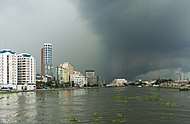

(2017-08-20).jpg)
(2018-06-04).jpg)
